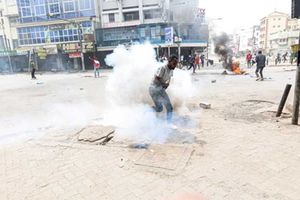Environmentalists raise concern as air pollution chokes cities, towns during protests

A boda boda rider drives past a burning tyre along Tom Mboya Street in Nairobi on July 16, 2024 during the anti-government protests.
What you need to know:
- The environmental impact of tyre burning extends beyond air pollution.
- The ash and residues left behind can leach into soil and water sources, contaminating them with heavy metals such as lead, cadmium and zinc.
Environmentalists have raised concern over pollution during protests in major towns and cities.
Mr Benson Pelipeli, an environmentalist from Mtelo Global Warming Network in West Pokot County, said the pollution has been caused by tyre burning, tear gas, rubber bullets, indiscriminate waste disposal on streets and trampling of grass, plants and other vegetation.
He also cited graffiti and other damages to public property, noting that they are harming the environment.
“The environmental impact of tyre burning extends beyond air pollution. The ash and residues left behind can leach into soil and water sources, contaminating them with heavy metals such as lead, cadmium and zinc. These contaminants can disrupt local ecosystems, harm wildlife, and enter the food chain, ultimately affecting human health.
“In agricultural regions, soil contamination can reduce crop yields and affect food security, disproportionately impacting communities that rely on farming,” said the environmental activist.
Mr Pelipeli wants action taken against those destroying the environment.
“We need to defend the natural environment. I am upset with what I have been seeing over the last couple of weeks,” he stated.
Mr Pelipeli said environmentalists are ready to move to court over the matter.
“Environmental activists across the world should intervene. We are ready to move to court. While these protests are often driven by a desire for justice and change, some of the methods employed such as burning tyres, destroying property and the use of tear gas canisters by police have unintended consequences,” he said.
Mr Pelipeli called on the government to take action against ‘financiers of the protests’ and urged the African Union to intervene.
He noted that global warming is real, saying the government should protect ecosystems key to the fight against climate change.
According to environmentalists, destruction of property including houses, businesses and public infrastructure during protests also has significant environmental repercussions.
“The actions contribute significantly to environmental degradation and perpetuate social injustices, creating a cycle of harm that affects both the planet and the most vulnerable populations. One of the most visible and immediate impacts of protests involving the burning of tyres is air pollution,” he said.
“Tyres are made of natural and synthetic rubber along with various chemicals and metals. When burned, they release toxic substances including sulfur dioxide, carbon monoxide, polycyclic aromatic hydrocarbons and volatile organic compounds. These pollutants can cause respiratory problems, cardiovascular diseases and other serious health issues,” he stated.
He said the black smoke from burning tyres contains fine particulate matter, which can penetrate deep into the lungs and enter the bloodstream.
“The smoke not only affects human health but also contributes to atmospheric pollution, exacerbating issues like smog and acid rain. With the ongoing violent protests, Kenya is likely to suffer the cumulative effects of tyre burning that may significantly degrade air quality, posing long-term health risks to citizens,” said Mr Pelipeli.
He added that environmental degradation caused by tyre burning and property destruction often exacerbates social injustices.
“Vulnerable populations, including low-income communities and marginalised groups, are disproportionately affected by the health impacts of pollution. These communities typically have less access to healthcare and are more likely to live in areas with poor air quality and inadequate waste management systems. This further entrenches social and economic inequalities.”
Secretary of Mtello Global group John Terengule said the destruction of homes and businesses during protests has led to displacement and loss of livelihoods for many individuals in major towns and cities. He noted that displaced persons may find themselves living in temporary shelters with inadequate facilities, increasing their vulnerability to health issues and social marginalisation.
“The loss of businesses can devastate local economies, particularly in areas where small enterprises are the primary source of income since Kenya is still a developing country. This economic disruption can lead to increased poverty as observed in some parts of the nation and social instability, creating a cycle of disenfranchisement and protests,” he stated.
He said the use of tear gas by police on the other hand during the protests adds another layer of environmental and social harm.
“Tear gas is composed of chemical compounds that cause severe irritation to the eyes, skin and respiratory system. While its effects are intended to be temporary, repeated exposure can lead to long-term health problems, particularly for individuals with pre-existing conditions such as asthma or other respiratory-related complications,” he stated.
Tree-planting champion Dinnah Lomunyang observed that tear gas can persist in the environment, contaminating soil and water sources.
“The chemicals can harm wildlife and disrupt ecosystems. In urban areas, which are highly populated, the use of teargas can exacerbate air pollution.”
“The persistence of tear gas means that its impacts are felt after the protests have ended, affecting both the natural environment and human populations like it has been frequently observed in our nation,” she stated





